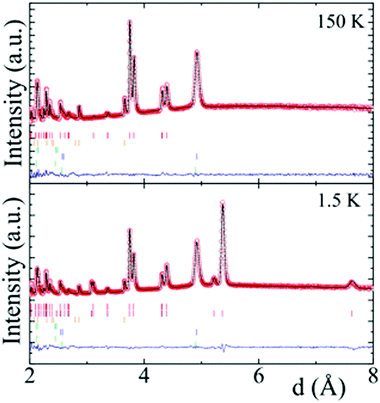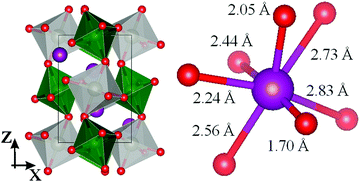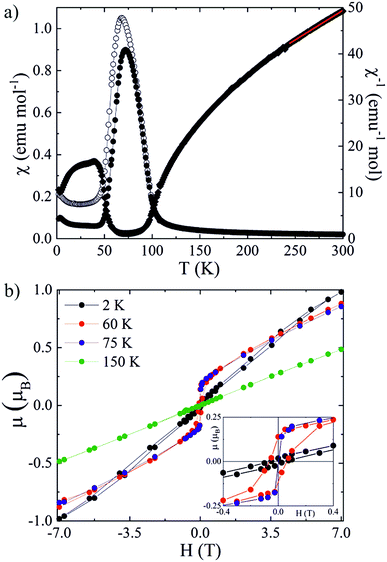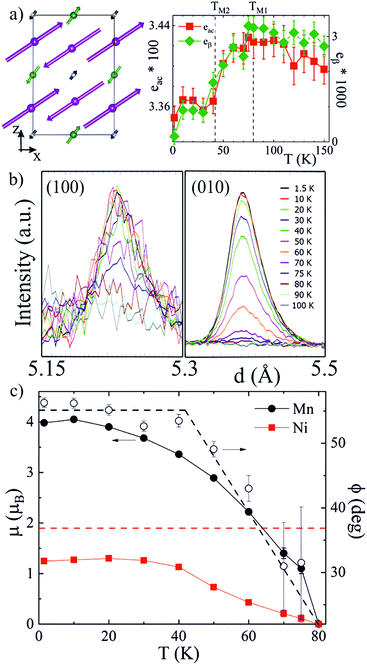 Open Access Article
Open Access ArticleUnconventional magnetism in the high pressure ‘all transition metal’ double perovskite Mn2NiReO6†‡
Elena
Solana-Madruga
a,
Khalid N.
Alharbi
a,
Maria
Herz
a,
Pascal
Manuel
b and
J. Paul
Attfield
 *a
*a
aCentre for Science at Extreme Conditions (CSEC) and School of Chemistry, University of Edinburgh, Mayfield Road, Edinburgh EH9 3JZ, UK. E-mail: j.p.attfield@ed.ac.uk
bISIS Facility, Rutherford Appleton, Laboratory, Harwell, Oxford, Didcot OX11 0QX, UK
First published on 14th September 2020
Abstract
Mn2NiReO6, prepared at high pressure and temperature, has a highly-distorted double perovskite structure. Canted antiferromagnetic order is observed below TM1 = 80 K and an unusual continuous spin rotation of Mn spins occurs down to TM2 = 42 K where a collapse in weak ferromagnetism evidences an unprecedented switching of the weak ferromagnetic moment directions.
A2BB′O6 double perovskites with rocksalt-type order of the B/B′ cations have been of great interest since the discovery of large magnetoresistances in Sr2FeMoO6.1,2 Double perovskites synthesised at ambient pressure typically have large, non-magnetic A-site cations like Ca2+, Sr2+, and Ba2+, but a recent breakthrough has come from the discovery that Mn2+ analogues can be recovered from high pressures. Complex magnetic orders result from the S = 5/2 Mn2+ A-site cations in addition to transition metal B-cation spins. Mn2FeSbO63 (and the basic ABO3-type perovskite MnVO3-II4) have incommensurate helimagnetic structures. The ‘All Transition Metal’ (ATM) double perovskite Mn2FeReO6 is ferrimagnetic with a high Curie temperature of 520 K and frustration switching of spin order and magnetoresistance on cooling.5,6 Mn2MnReO6 is also frustrated with perpendicular A and B site Mn2+ sublattices7,8 and Mn2CoReO6 is antiferromagnetically ordered below 94 K.9 Here we report the new ATM double perovskite Mn2NiReO6 which shows remarkable Mn2+ spin rotation and weak ferromagnetic properties.
Mn2NiReO6 was synthesised at 8 GPa and 1573 K using a Walker-type multi-anvil press. Stoichiometric proportions of MnO, NiO and ReO3 were ground in acetone and packed into a Pt capsule. The product was quenched to room temperature and slowly depressurized. Formation of a double perovskite was confirmed using powder X-ray diffraction (XRD) from a Bruker D2-Phaser instrument, and high resolution neutron powder diffraction (NPD) data were collected using the WISH instrument at ISIS. Long NPD scans were taken at 1.5, 75, and 150 K to determine crystal and magnetic structures, and shorter scans at intermediate temperatures were used to reveal their thermal evolutions. Diffraction data were fitted using the FullProf software suite.10 Magnetic susceptibility was measured using a superconducting quantum interference device (SQUID) Quantum Design XL-MPMS magnetometer in the temperature range 2–300 K under zero-field cooling (ZFC) and field-cooling (FC) conditions in a magnetic field of 1000 Oe. Magnetisation-field hysteresis loops were collected at 2, 60, 75 and 150 K under applied magnetic fields up to 7 T.
Mn2NiReO6 was found to have a monoclinic P21/n double perovskite crystal structure from refinements against XRD and NPD data (Fig. 1 and ESI,‡ Fig. S1). Secondary phases of ReO2, NiO and another rocksalt type phase, Ni0.67Mn0.33O11 (17.8(6) wt%, 4.0(3) wt% and 12.2(2) wt% respectively), were also fitted. See ESI‡ for further discussion. The large contrasts in neutron scattering lengths for Mn, Ni, Re and O (−3.73, 10.3, 9.2 and 5.8 fm respectively)12 enable accurate determination of the cation distribution and oxygen positions. Structure refinement using the 150 K NPD data, summarized in ESI,‡ Table S1, reveals that the Mn and Re sites are fully occupied but 18% Mn substitutes for Ni, so the overall chemical composition Mn2.18Ni0.82ReO6 is in keeping with the Ni-rich impurities observed.
The interatomic distances, as summarized in Fig. 2 and Table S1 (ESI‡), show that the structure of Mn2NiReO6 is highly distorted from the ideal double perovskite arrangement. The A-site Mn coordination is reduced from the ideal perovskite 12-fold environment to an irregular 7-coordinate polyhedron, with Mn–O distances ranging from 1.70 to 2.83 Å (and other distances >3.10 Å, see ESI,‡ Table S5). This differs from other Mn2BB′O6 double perovskites where 8-coordination of Mn up to a similar distance limit was reported.3,5–9,13–15 Mn2NiReO6 also has a very short Mn–O distance of 1.70 Å showing that the structure is highly distorted. (Short Mn2+–O distances have also been reported in high pressure Mn3O4.16) A comparison against other Mn2BB′O6 double perovskites in ESI‡ shows that Mn2NiReO6 has the largest octahedral tilt angles and distortion parameters reported in this family to date. Although bond distances and derived Bond Valence Sums in ESI‡ do not distinguish clearly between Ni2+/Re6+ and Ni3+/Re5+ charge distributions,17 magnetic moments refined against 1.5 K NPD data indicate Ni2+/Re6+, as also found in Sr2NiReO6.18,19
Temperature variation of magnetic susceptibility is shown in Fig. 3a. The Curie–Weiss fit shown gives an effective paramagnetic moment of 8.16 μB f.u.−1 which is comparable to the spin-only estimate of 9.0 μB per unit Mn2NiReO6, given the presence of secondary phases. The fitted Weiss constant is θ = 1.8 K but this may not be meaningful given the presence of impurities and extrapolation from a small fitting range. A sharp ferro- or ferrimagnetic transition with divergence of ZFC and FC data is observed at TM1 = 80 K, and a discontinuity reveals a second magnetic transition at TM2 = 42 K. Magnetic hysteresis loops at 60 and 75 K in Fig. 3b show a small net moment of 0.17 μB f.u.−1, indicating that a weak ferromagnetic order is present below TM1. However, at 2 K, below the second magnetic transition, the loop has almost collapsed with a residual moment of 0.02 μB f.u.−1 although the coercive field of 51 mT is comparable to the 60 K value of 63 mT.
Magnetic peaks from Mn2NiReO6 are observed in neutron powder diffraction (NPD) patterns below TM1 = 80 K, as shown in Fig. 1 and 4. All magnetic peaks are indexed by propagation vector k = [0 0 0] and fits of different models from magnetic symmetry analysis10 showed that the Mn, Ni, and Re spins all follow the same irreducible representation corresponding to antiferromagnetic order of spins in the ac-plane, as shown in Fig. 4a. All moments are ordered below 80 K. Ni2+ and Re6+ site moments were found to have magnitudes in a ratio near 2![[thin space (1/6-em)]](https://www.rsc.org/images/entities/char_2009.gif) :
:![[thin space (1/6-em)]](https://www.rsc.org/images/entities/char_2009.gif) 1 and were constrained to this ratio following their ideal S values for stability of the magnetic fits. Full refinement of the crystal and magnetic structures at 1.5 K gave respective moments of 3.98(3), 1.25(1) and 0.62 μB for Mn2+, Ni2+ and Re6+. These are lower than their ideal 5, 2 and 1 μB values evidencing the magnetic frustration within the highly connected networks of the three magnetic cations as well as the Ni/Mn disorder. Magnetic moments for 5d cations are also known to be reduced by effects of large spin–orbit coupling and strong hybridization with oxygen.20–22
1 and were constrained to this ratio following their ideal S values for stability of the magnetic fits. Full refinement of the crystal and magnetic structures at 1.5 K gave respective moments of 3.98(3), 1.25(1) and 0.62 μB for Mn2+, Ni2+ and Re6+. These are lower than their ideal 5, 2 and 1 μB values evidencing the magnetic frustration within the highly connected networks of the three magnetic cations as well as the Ni/Mn disorder. Magnetic moments for 5d cations are also known to be reduced by effects of large spin–orbit coupling and strong hybridization with oxygen.20–22
The magnetic structure of Mn2NiReO6 has moments coupled parallel in the c-direction but antiparallel in the ab-plane through Ni–O–Re and Mn–O–Mn linkages, demonstrating the presence of competing ferro- and anti-ferromagnetic interactions, in keeping with the small Weiss temperature. In an ideal, undistorted, double perovskite, 180° M–O–M′ superexchange interactions between t12g Re6+ and t62ge2g Ni2+ are expected to be ferromagnetic whereas couplings between t32ge2g Mn2+ ions would be antiferromagnetic, and a variety of 90° M–O–M′ interactions are also present.
Magnetic peaks intensities from Mn2NiReO6 are found to evolve differently on cooling, for example, the (100) peak shown in Fig. 4b is essentially saturated below ∼50 K, while the (010) intensity continues to grow down to 10 K. This demonstrates that spin components parallel to these planes grow at different rates, and refinements showed that spin rotation occurs in the ac-plane as the spin order saturates. Initial fits showed that the spin direction for Ni (and Re) sites does not change significantly with temperature, and so in the final fits, the Ni (and Re) spin direction was fixed while the Mn x- and z-components were refined independently (see ESI‡ for details). The resulting moments and rotation angles ϕ (defined as the angle of rotation from +c towards +a in the xz-plane) are shown in Fig. 4c. The monoclinic symmetry of Mn2NiReO6 enables the sign of the rotation angles ϕ to be determined.
The thermal variation of spin angles in Fig. 4c shows that Mn spins initially order with ϕMn ≈ 30° just below TM1 = 80 K. This is within error of the constant ϕB = 36° tilt angle that the ordered Ni and Re site moments exhibit at all temperatures, so all spins are essentially collinear just below TM1. The tilts of the NiO6 and ReO6 octahedra are respectively ψNi = −ψ and ψRe = +ψ, following the same sign convention as for the spin rotation angles ϕ, where the octahedral tilt angle is ψ = 23° as shown in ESI.‡ The opposite signs of ψNi and ψRe result from their out-of-phase tilting in the z-direction (Fig. 2). Hence all ordered spins are near parallel to the tilted axis of the ReO6 octahedra immediately below TM1. This likely results from the strong electronic anisotropy of 5d1 Re6+, as 3d8 Ni2+ and high spin 3d5 Mn2+ both have non-degenerate ground states.
Although spin reorientation transitions, where spin directions switch from one fixed direction to another, are known in double perovskites, e.g. Sr2CoOsO6,20 continuous changes of spin direction over a broad temperature range do not usually occur. Spin directions remain fixed in all of the previously reported Mn2BB′O6 double perovskites shown in ESI‡ except for the reorientation transition in Mn2FeReO6.6 However, the Mn spin angle ϕMn in Mn2NiReO6 increases continuously from ϕMn ≈ 30° just below TM1 = 80 K to ϕMn = 55° at TM2 = 42 K. ϕMn is effectively constant below TM2, so the second transition marks a change between rotating and non-rotating Mn2+ spin phases. This is most likely driven by frustration between the spin orders. Each Mn spin is surrounded by two ‘up’ and two ‘down’ Ni and Re spins, and each Ni or Re spin has four ‘up’ and four ‘down’ Mn spin neighbours. The monoclinic lattice distortion breaks the equivalence of spin–spin interactions and couples the spin orders, as evidenced by discontinuities at TM1 and TM2 in lattice strains eac = 1 − √2a/c and eb = cos![[thin space (1/6-em)]](https://www.rsc.org/images/entities/char_2009.gif) β measured from the refined cell parameters (see ESI‡) observed in Fig. 4a.
β measured from the refined cell parameters (see ESI‡) observed in Fig. 4a.
Neutron diffraction reveals antiferromagnetic ordering of the Mn, Ni, and Re spins in Mn2NiReO6, but the magnetisation data in Fig. 3 show that a small ferromagnetic component is also present. This is explained by the presence of non-zero antisymmetric Dzyaloshinskii–Moriya exchange interactions leading to canting of the moments. Symmetry analysis in ESI‡ shows that the irreducible representation describing the observed antiferromagnetic orders of spins in the ac-plane also permits ferromagnetic components in the b direction, although these are too small to be detected by NPD. Such weak ferromagnetism is common in perovskites where octahedral tilting lowers symmetry and can used to generate electrical polarisation and hence multiferroic properties.23
All three of the antiferromagnetic Mn, Ni, and Re sublattices in Mn2NiReO6 give rise to ferromagnetic components. It is notable that the net ferromagnetic moment takes a relatively large value ∼0.17 μB f.u.−1 in the rotating-spin phase on cooling below TM1 = 80 K, but collapses to a much smaller value ∼0.02 μB f.u.−1 approaching TM2 = 42 K below which spin directions are fixed. A possible explanation for this is that the relative directions of some of the ferromagnetic components switch at the TM2 transition. A switch from +++ directions of the respective weak ferromagnetic moments of Mn, Ni and Re spins above TM2, aligned with the applied field, to +−− below, driven by antiferromagnetic coupling between the ferromagnetic y-components at the A and at the B, B′ sublattices as the spins become more fully ordered, accounts for the observed sharp magnetisation change at TM2. Such a transition based on switching of weak ferromagnetic moments from a ferro- to a ferri-magnetic order is unprecedented and demonstrates a further new possibility generated by having magnetic A and B sublattices in ‘all transition metal’ perovskites.
In conclusion, the new ATM double perovskite Mn2NiReO6 prepared under high pressure and high temperature conditions shows a high degree of Mn2+/Ni2+/Re6+ cation order although 18% excess of Mn2+ substitutes for Ni. The monoclinic structure of Mn2NiReO6 is highly distorted with the largest octahedral tilt angles and distortion parameters reported for in the Mn2BB′O6 family to date. All three magnetic sublattices order simultaneously at TM1 = 80 K with antiferromagnetically-oriented spins, and an unusual change between rotating and non-rotating Mn2+ spin phases at TM2 = 42 K. Weak ferromagnetism due to spin canting is observed but the net magnetisation undergoes a collapse at TM2, consistent with switching of the relative directions of the weak ferromagnetic moments at the different sublattices from a ferro- to a ferri-magnetic arrangement. The unusual spin rotation, not seen in other Mn2BB′O6 analogues, and the novel switching of weak ferromagnetic states demonstrate further new possibilities that arise from interacting magnetic A and B sublattices in highly distorted ‘all transition metal’ double perovskite lattices.
We acknowledge EPSRC for funding and STFC for beamtime allocation at ISIS. K. N. A. acknowledges funding from King Abdulaziz City for Science and Technology (KACST).
Conflicts of interest
There are no conflicts to declare.Notes and references
- K.-I. Kobayashi, T. Kimura, H. Sawada, K. Terakura and Y. Tokura, Nature, 1998, 395, 677–680 Search PubMed.
- S. Vasala and M. Karppinen, Prog. Solid State Chem., 2015, 43, 1–36 Search PubMed.
- A. J. Dos santos-García, C. Ritter, E. Solana-Madruga and R. Sáez-Puche, J. Phys.: Condens. Matter, 2013, 25, 206004 Search PubMed.
- M. Markkula, A. M. Arevalo-Lopez, A. Kusmartseva, J. A. Rodgers, C. Ritter, H. Wu and J. P. Attfield, Phys. Rev. B: Condens. Matter Mater. Phys., 2011, 84, 094450 Search PubMed.
- M.-R. Li, M. Retuerto, Z. Deng, P. W. Stephens, M. Croft, Q. Huang, H. Wu, X. Deng, G. Kotliar, J. Sánchez-Benítez, J. Hadermann, D. Walker and M. Greenblatt, Angew. Chem., Int. Ed., 2015, 54, 12069–12073 Search PubMed.
- A. M. Arévalo-López, G. M. McNally and J. P. Attfield, Angew. Chem., Int. Ed., 2015, 54, 12074–12077 Search PubMed.
- M.-R. Li, J. P. Hodges, M. Retuerto, Z. Deng, P. W. Stephens, M. C. Croft, X. Deng, G. Kotliar, J. Sánchez-Benítez, D. Walker and M. Greenblatt, Chem. Mater., 2016, 28, 3148–3158 Search PubMed.
- A. M. Arévalo-López, F. Stegemann and J. P. Attfield, Chem. Commun., 2016, 52, 5558–5560 Search PubMed.
- C. E. Frank, E. E. McCabe, F. Orlandi, P. Manuel, X. Tan, Z. Deng, M. Croft, V. Cascos, T. Emge, H. L. Feng, S. Lapidus, C. Jin, M. X. Wu, M. R. Li, S. Ehrlich, S. Khalid, N. Quackenbush, S. Yu, D. Walker and M. Greenblatt, Chem. Commun., 2019, 55, 3331–3334 Search PubMed.
- J. Rodriguez-Carvajal, Physica B, 1993, 192, 55–69 Search PubMed.
- E. Solana-Madruga, Y. Sun, A. M. Arévalo-López and J. P. Attfield, Chem. Commun., 2019, 55, 2605–2608 Search PubMed.
- V. F. Sears, Neutron News, 1992, 3, 26–37 Search PubMed.
- E. Solana-Madruga, A. J. Dos santos-García, A. M. Arévalo-López, D. Ávila-Brande, C. Ritter, J. P. Attfield and R. Sáez-Puche, Dalton Trans., 2015, 44, 20441–20448 Search PubMed.
- A. J. Dos santos-García, E. Solana-Madruga, C. Ritter, D. Ávila-Brande, O. Fabelo and R. Sáez-Puche, Dalton Trans., 2015, 44, 10665–10672 Search PubMed.
- A. M. Arévalo-López, E. Solana-Madruga, C. Aguilar-Maldonado, C. Ritter, O. Mentré and J. P. Attfield, Chem. Commun., 2019, 55, 14470–14473 Search PubMed.
- S. Hirai, A. M. dos Santos, M. C. Shapiro, J. J. Molaison, N. Pradhan, M. Guthrie, C. A. Tulk, I. R. Fisher and W. L. Mao, Phys. Rev. B: Condens. Matter Mater. Phys., 2013, 87, 014417 Search PubMed , distances are shown in ICSD CIF file 188903.
- T. Stoyanova-Lyubenova, A. J. Dos santos-García, E. Urones-Garrote, M. J. Torralvo and M. Á. Alario-Franco, Dalton Trans., 2014, 43, 1117–1124 Search PubMed.
- H. Kato, T. Okuda, Y. Okimoto and Y. Tomioka, Phys. Rev. B: Condens. Matter Mater. Phys., 2004, 69, 184412 Search PubMed.
- M. Retuerto, M. J. Martínez-Lope, M. García-Hernández, M. T. Fernández-Díaz and J. A. Alonso, Eur. J. Inorg. Chem., 2008, 588–595 Search PubMed.
- R. Morrow, R. Mishra, O. D. Restrepo, M. R. Ball, W. Windl, S. Wurmehl, U. Stockert, B. Büchner and P. M. Woodward, J. Am. Chem. Soc., 2013, 135, 18824–18830 Search PubMed.
- R. Morrow, J. W. Freeland and P. M. Woodward, Inorg. Chem., 2014, 53, 7983–7992 Search PubMed.
- P. Kayser, S. Injac, B. J. Kennedy, T. Vogt, M. Avdeev and H. E. Maynard-Casely, Inorg. Chem., 2017, 56, 6565–6575 Search PubMed.
- N. A. Spaldin and R. Ramesh, Nat. Mater., 2019, 18, 203–212 Search PubMed.
Footnotes |
| † Data that support the findings of this study have been deposited at https://datashare.is.ed.ac.uk/handle/10283/838. |
| ‡ Electronic supplementary information (ESI) available: Supporting figures and tables. See DOI: 10.1039/d0cc04756b |
| This journal is © The Royal Society of Chemistry 2020 |




